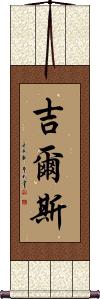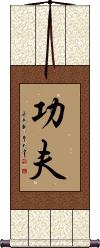Many custom options...
And formats...

Giles in Chinese / Japanese...
Buy a Giles calligraphy wall scroll here!
Personalize your custom “Giles” project by clicking the button next to your favorite “Giles” title below...
Giles
Giles
Chan
Taiwanese Surname
This is a surname that romanizes as Chan from the Taiwanese (Wade-Giles) method or romanizing Mandarin Chinese.
The actual meaning is excellent or verbose.
Kung Fu / Gong Fu
功夫 or Kung Fu is one of the most famous types of martial arts in the world - and not just because of Bruce Lee.
Some translate the meaning as “Accomplishment by Great Effort.” I think this is partially true, but directly translated, it literally means “Merit/Achievement/Accomplishment Man.” The word “fu” can sometimes mean “husband” or “porter,” but in this case, it can only mean “man.” However, few in China will think “man” when they hear the word “Gong Fu” spoken.
This term is also used for things other than martial arts. In fact, it's used to refer to a person with excellent skills in crafts that require a lot of effort to master, such as cooking, tea ceremonies, and calligraphy.
What a lot of people don't know is that the spelling of “Kung Fu” was actually taken from the old Wade Giles form of Romanization. Using this method, the sounds of the English “G” and “K” were both written as “K” and an apostrophe after the “K” told you it was supposed to sound like a “G.” Nobody in the west knew this rule, so most people pronounce it with a “K-sound.” And so, Gong Fu will always be Kung Fu for most westerners.
Also, just to educate you a little more, the “O” in “Gong” has a sound like the English word “oh.”
The popular Chinese dish “Kung Pao Chicken” suffers from the same problem. It should actually be “Gong Bao Chicken.”
Historical note: Many will claim that Kung Fu was invented by the monks of the Shaolin monastery. This fact is argued in both directions by scholars of Chinese history. Perhaps it is more accurate to say that the Shaolin Monks brought the original fame to Kung Fu many generations ago.
Japanese note: While most Japanese martial artists will recognize these characters, Katakana is more often used to approximate the pronunciation of "Kung Fu" with "カンフー." Some will argue as to whether this should be considered a Japanese word at all.
See Also: Bruce Lee
Not the results for Giles that you were looking for?
Below are some entries from our dictionary that may match your Giles search...
| Characters If shown, 2nd row is Simp. Chinese |
Pronunciation Romanization |
Simple Dictionary Definition |
ジャイルズ see styles |
jairuzu ジャイルズ |
More info & calligraphy: Giles |
威翟 see styles |
wēi zhái wei1 zhai2 wei chai |
Wade-Giles (romanization system for Chinese) |
玄奘 see styles |
xuán zàng xuan2 zang4 hsüan tsang genjou / genjo げんじょう |
Xuanzang (602-664), Tang dynasty Buddhist monk and translator who traveled to India 629-645 (given name) Genjō; (person) Xuanzang (602-664) Xuanzang, whose name is written variously e. g. Hsüan Chuang, Hiüen-tsang, Hiouen Tsang, Yüan Tsang, Yüen Chwang; the famous pilgrim to India, whose surname was 陳 Chen and personal name 禕 Wei; a native of Henan, A. D. 600-664 (Giles). It is said that he entered a monastery at 13 years of age and in 618 with his elder brother, who had preceded him in becoming a monk, went to Chang-an 長安, the capital, where in 622 he was fully ordained. Finding that China possessed only half of the Buddhist classics, he took his staff, bound his feet, and on foot braved the perils of the deserts and mountains of Central Asia. The date of his setting out is uncertain (629 or 627), but the year of his arrival in India is given as 633: after visiting and studying in many parts of India, he returned home, reaching the capital in 645, was received with honour and presented his collection of 657 works, 'besides many images and pictures, and one hundred and fifty relics, 'to the Court. Taizong, the emperor, gave him the 弘福寺 Hongfu monastery in which to work. He presented the manuscript of his famous 大唐西域記 Record of Western Countries in 646 and completed it as it now stands by 648. The emperor Gaozong called him to Court in 653 and gave him the 慈恩寺 Cien monastery in which to work, a monastery which ever after was associated with him; in 657 he removed him to the 玉華宮 Yuhua Gong and made that palace a monastery. He translated seventy-five works in 1335 juan. In India he received the titles of 摩訶耶那提婆 Mahāyānadeva and 木叉提婆 Mokṣadeva; he was also known as 三藏法師 Tripiṭaka teacher of Dharma. He died in 664, in his 65th year. |
威妥瑪 威妥玛 see styles |
wēi tuǒ mǎ wei1 tuo3 ma3 wei t`o ma wei to ma |
Sir Thomas Francis Wade (1818-1895), British diplomat and sinologist, originator of the Wade-Giles Chinese romanization system |
翟理斯 see styles |
zhái lǐ sī zhai2 li3 si1 chai li ssu |
Herbert Allen Giles (1845-1935), British diplomat and linguist, contributor to the Wade-Giles Chinese romanization system |
威瑪拼法 威玛拼法 see styles |
wēi mǎ pīn fǎ wei1 ma3 pin1 fa3 wei ma p`in fa wei ma pin fa |
Wade-Giles system (romanization of Chinese) |
威瑪拼音 威玛拼音 see styles |
wēi mǎ pīn yīn wei1 ma3 pin1 yin1 wei ma p`in yin wei ma pin yin |
Wade-Giles system (romanization of Chinese) |
韋氏拼法 韦氏拼法 see styles |
wéi shì pīn fǎ wei2 shi4 pin1 fa3 wei shih p`in fa wei shih pin fa |
Wade-Giles system (romanization of Chinese) |
ウェード式 see styles |
weedoshiki ウェードしき |
Wade-Giles romanization (of Chinese) |
威妥瑪拼法 威妥玛拼法 see styles |
wēi tuǒ mǎ pīn fǎ wei1 tuo3 ma3 pin1 fa3 wei t`o ma p`in fa wei to ma pin fa |
Wade-Giles system (romanization of Chinese) |
威妥瑪拼音 威妥玛拼音 see styles |
wēi tuǒ mǎ pīn yīn wei1 tuo3 ma3 pin1 yin1 wei t`o ma p`in yin wei to ma pin yin |
Wade-Giles system (romanization of Chinese) |
威氏註音法 威氏注音法 see styles |
wēi shì zhù yīn fǎ wei1 shi4 zhu4 yin1 fa3 wei shih chu yin fa |
Wade-Giles transliteration scheme for Chinese |
サンアンドレスデヒレス see styles |
sanandoresudehiresu サンアンドレスデヒレス |
(place-name) San Andres de Giles |
The following table may be helpful for those studying Chinese or Japanese...
| Title | Characters | Romaji (Romanized Japanese) | Various forms of Romanized Chinese | |
| Giles | 吉爾斯 吉尔斯 | jí ěr sī ji2 er3 si1 ji er si jiersi | chi erh ssu chierhssu |
|
| Giles | ジャイルズ | jairuzu | ||
| Chan | 詹 | zhān / zhan1 / zhan | chan | |
| Kung Fu Gong Fu | 功夫 | kan fu / ku fu kanfu / kufu | gōng fu / gong1 fu / gong fu / gongfu | kung fu / kungfu |
| In some entries above you will see that characters have different versions above and below a line. In these cases, the characters above the line are Traditional Chinese, while the ones below are Simplified Chinese. | ||||
Successful Chinese Character and Japanese Kanji calligraphy searches within the last few hours...







